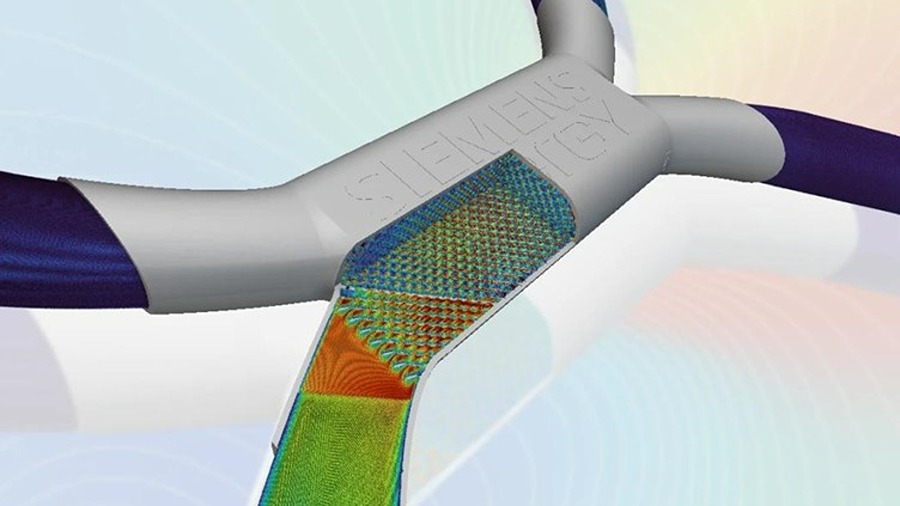
MUNICH, Germany, June 6, 2025 – SimScale has introduced an integration with nTop’s computational design platform, enabling engineers to import implicit geometry into the SimScale environment. This connection supports simulation workflows for advanced heat exchangers. By using implicit geometry, users can run simulations with stability and speed to assess design variants within a single workflow.
Accelerating design cycles for high performance heat exchangers
This capability enables simulation of flow and thermal behavior in complex heat exchanger designs. It removes the bottlenecks of CAD conversion and surface meshing, improving efficiency in evaluating DfAM components.
“Traditional simulation pipelines struggle with the complexity of high-performance heat exchanger geometries because they require faceted CAD data, which is a time-consuming step” said Alexander Fischer, product manager and co-founder at SimScale. “With this new integration, engineers can move from design to simulation in a fraction of the time, much more reliably.”
“Traditional CAD-to-simulation workflows have always been a major bottleneck in high-performance heat exchanger design – you’re constantly dealing with meshing failures and geometry conversion issues that kill iteration speed,” said Bradley Rothenberg, co-founder and CEO of nTop. “This native integration with SimScale eliminates that friction — Engineers can now move directly from nTop implicit geometry into a robust thermal and flow solver without the preprocessing headaches, enabling teams to iterate faster and explore design spaces that were previously impractical to simulate.”
Faster and more robust conjugate heat transfer simulation with implicit geometry
Legacy simulation tools depend on CAD imports and manual pre-processing, which can lead to errors and delays. SimScale’s new functionality, developed in collaboration with nTop, allows engineers to use implicit models. This supports robust flow and conjugate heat transfer (CHT) simulations using SimScale’s immersed boundary method (IBM), which processes implicit geometries without conversion or discretization.
The result: a simulation workflow that supports iterative design and evaluation of complex heat exchangers. This approach is in use by organizations like Siemens Energy.
“Implicit modeling and direct simulations on implicit geometry is a real step change in speed and robustness of optimization workflows and necessary to unlock the real potential of additive manufacturing.” – says Markus Lempke, computational designer at Siemens Energy.
All SimScale users, including community users and professional license holders, can take advantage of this capability to import implicit models from nTop into SimScale, enabling simulation workflows for DfAM products.
Source: SimScale
About SimScale
![]()
SimScale GmbH, founded in 2012 and based in Munich, Germany, provides a cloud-native platform for engineering simulation. Its browser-based Software-as-a-Service model gives users access to tools for computational fluid dynamics (CFD), finite element analysis (FEA), thermal analysis, and electromagnetics without requiring local high-performance computing resources. The platform is used across industries including architecture, automotive, electronics, energy, and industrial equipment, supporting tasks such as virtual prototyping and performance optimization. As of 2025, SimScale serves more than 600,000 users in over 100 countries and employs around 150 people globally. The company reports an estimated annual revenue of $29.2 million and has secured $29 million in funding. Recent developments include the integration of AI-driven simulation capabilities and partnerships with PTC and Arena. These efforts reflect a continued focus on improving accessibility and scalability for simulation-led design workflows in engineering.
About nTop

nTop, formerly known as nTopology, is a New York-based engineering software company founded in 2015. It develops a computational design platform focused on performance-driven applications such as additive manufacturing, generative design, and simulation-based engineering. The software uses implicit modeling and reusable workflows to enable the creation of complex parts that are difficult to design using traditional CAD tools. nTop is used by engineering teams in aerospace, automotive, medical devices, energy, and defense to accelerate design iteration and improve functional performance. Its platform integrates GPU-accelerated modeling, simulation feedback, and automation to support exploration of multiple design variants within reduced timeframes. As of 2025, nTop serves more than 400 customers in over 30 countries, employs around 130 people, and reports estimated annual revenue between $10 million and $50 million. The company has raised $135 million in funding and recently acquired Cloudfluid GmbH to expand its capabilities in computational fluid dynamics (CFD).
